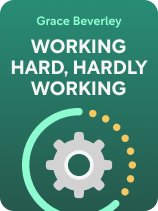

This article is an excerpt from the Shortform book guide to "Working Hard, Hardly Working" by Grace Beverley. Shortform has the world's best summaries and analyses of books you should be reading.
Like this article? Sign up for a free trial here.
Are productivity and self-care mutually exclusive? How can they feed each other and even operate together?
According to Grace Beverley, productivity and self-care can work together in supportive cycles. She shares four strategies that will help you be more efficient, thereby freeing up time for self-care. In turn, this energizes you to get more done. She also shows how you can engage in self-care while working.
Keep reading to get these valuable strategies that can transform the way you work and live.
Grace Beverley on Productivity & Self-Care
We’ll explore four of Grace Beverley’s productivity and self-care strategies:
- Make your work more enjoyable.
- Meet your needs while you’re in flow (a state of enjoyable focus).
- Engage in self-care-only time.
- Use your work time wisely.
(Shortform note: The strategies Beverley proposes for overcoming overwork and burnout are specifically strategies for individuals to implement. By contrast, others argue that it’s primarily the responsibility of employers and organizations to solve the problems of overwork and burnout. It’s arguably in their best interests to do so, as employee burnout leads to issues that harm companies and organizations, such as high turnover. Experts recommend that leaders implement strategies such as allocating job responsibilities more fairly, reducing employee overtime, and offering a four-day workweek.)
Strategy 1: Make Work More Enjoyable
Beverley says you can engage in self-care while working by making your work more enjoyable. That way, your time spent working productively won’t be depleting—instead, the joy you get from working will energize and satisfy you.
Let’s explore three of Beverley’s tips for making your work more enjoyable.
Tip 1: Incorporate Satisfying Tasks Into Your Workday
First, Beverley recommends ensuring that your workday involves many satisfying tasks (what she calls “micro-passions”). When you fill every day with multiple satisfying tasks, those days amount to a satisfying life.
To implement this tip, make a list of work-related tasks you find satisfying. Then, make a plan to incorporate more of those tasks into your typical workday. Beverley notes that this may require making large changes, such as asking your boss for additional (or different) responsibilities or pursuing professional development that will improve your skills. If those changes aren’t possible, it could be a sign that you should switch roles or careers.
For example, imagine you’re a teacher who enjoys the tasks of supporting your colleagues and learning new teaching techniques. You could ask your boss if you can start mentoring new teachers, or you could seek out professional development opportunities that will expand your teaching skills. If these changes aren’t possible, consider switching to a role in which these satisfying tasks feature prominently, such as becoming an instructional coach (a teacher of teachers).
Tip 2: Make Your Work Original
Second, Beverley argues that we find work more satisfying when we complete tasks in an original way. She explains that when we leverage our unique strengths to create original work, the result is more valuable because someone else can’t easily replicate it. Feeling valuable in this way gives us joy and satisfaction.
How can you make your work original? Beverley says to engage in warm-ups (what she calls “creative triggers”) that will inspire you to think outside the box before you complete work tasks. Warm-ups she recommends include drawing something relevant to your work task, listening to a podcast on a related topic, and brainstorming relevant ideas with others.
For example, say you’re a musician who posts lessons about musical concepts on YouTube. You begin one workday by doodling on paper while listening to a song you want to teach. This warm-up gives you the idea to represent the song visually in your video for it, using rising lines to represent ascending melodies, falling lines to indicate descending ones, and wavy lines to show vibrato.
Tip 3: Set Yourself Up to Experience Flow
Beverley offers a third tip for making your workdays more enjoyable: experience flow. She explains that, according to psychologist Mihaly Csikszentmihalyi, flow is a state in which you’re deeply absorbed in a task. Beverley says that flow makes productivity a form of self-care because the feeling of being engrossed in a task is joyful and satisfying.
According to Csikszentmihalyi, you experience flow when you’re engaged in a task in which your skill level matches the level of challenge you feel. If you’re not experiencing flow because a task is too easy, you can enter flow by making the task more challenging. If you’re unable to access flow because a task is too difficult, improve your skills.
Beverley advises that it’s easiest to enter flow states when working on tasks that are already conducive to flow. Start by identifying tasks that have put you into a state of flow before.Think of instances in which you felt completely engaged in a work task, such as moments when you lost track of time.
Next, instead of waiting for flow to happen when you engage in these tasks, purposefully initiate flow. Engage in a brief warm-up activity (Beverley calls these “flow triggers”) that inspires you to work on the tasks you identified. For instance, say you’re a graphic designer who has experienced flow in the past when sketching logo ideas. You could initiate flow by looking at pictures of your favorite logos for inspiration before designing your own.
Strategy 2: Meet Your Needs While You’re in Flow
Making tasks more enjoyable isn’t the only way to engage in self-care while working; Beverley says you can also attend to your needs (physical and otherwise). We’ll focus on Beverley’s advice for taking care of your needs while you’re in a state of flow, specifically. Even though flow is an enjoyable state, Beverley warns that it can lead to overwork. Let’s explore two of Beverley’s tips for avoiding this.
Tip 1: Prepare to Meet Your Physical Needs
When you’re experiencing flow, you might be so absorbed in a task that you forget to take care of yourself. Therefore, before starting a task that’ll get you into flow, prepare to meet your physical needs. For instance, fill your water bottle in advance and make sure your workspace is comfortable.
Tip 2: Decide in Advance How Long to Spend in Flow
Furthermore, if you spend too much time in flow, you’ll become mentally and physically exhausted—Beverley calls this “overflow.” Therefore, set a time limit for your flow session in advance. Enforce this limit by ensuring you’ll know to stop when that time is up—for example, set up a desktop notification to remind you when your flow period has ended.
Strategy 3: Engage in Self-Care-Only Time
So far, we’ve explored how to integrate self-care and productivity by bringing self-care time into your work time. However, Beverley also says it’s important to engage in pure self-care outside of productivity time so you can regularly experience the benefits of work-free leisure. Remind yourself that self-care-only time still supports your productivity by leaving you feeling rejuvenated and ready to be productive.
Let’s explore two of Beverley’s tips for engaging in self-care-only time.
Tip 1: Discover What Self-Care Means to You
Beverley argues that there isn’t a single set of self-care activities that work for everyone, since we all have different needs and interests. Therefore, take time to experiment with various self-care activities. First, try out any activities that could be considered self-care—anything that feels good and could therefore leave you rejuvenated, such as playing a board game or photographing your pet. Keep a record of which activities have the most positive impact on your mental health and productivity. Then, make those your go-to self-care activities.
Tip 2: Schedule Self-Care-Only Time Before You Burn Out
Beverley says we typically only engage in self-care-only activities in reaction to symptoms of burnout (such as exhaustion). This self-care doesn’t prevent burnout, however—it just manages its symptoms. Fortunately, Beverley says you can prevent burnout and its symptoms by proactively scheduling self-care-only time and protecting that time.
For example, say you find reading romance novels rejuvenating. Commit to spending every Saturday morning reading romance novels for two hours, and protect this self-care time by doing your chores beforehand and turning down any social invitations that conflict with this time.
Strategy 4: Use Your Work Time Wisely
Making time for self-care is possible only if you use your work time productively. When you work effectively and efficiently, you can work fewer hours, leaving more time for self-care.
Let’s explore three of Beverley’s tips for using your work time productively.
Tip 1: Ditch the To-Do List for the Eisenhower Method
A conventional to-do list includes a lineup of tasks you must complete, whether they’re in order of importance or not. Beverley argues that to-do lists aren’t conducive to productivity because they fail to prioritize tasks. For instance, they might place unimportant tasks or tasks with far-off deadlines higher on the list than tasks that are important and time-sensitive. As a result, you waste your time on unimportant tasks and work more hours than you need to.
Beverley recommends the Eisenhower Method (EM) as a replacement for the traditional to-do list. The EM has you assess how crucial and pressing your tasks are so you can decide which to prioritize, which to delegate to others, and which to skip. Crucial tasks are important to complete at some point to achieve your long-term goals, while pressing tasks have upcoming deadlines. To implement the EM, follow these four steps.
First, complete crucial and pressing tasks. For example, if you’re a journalist, work first on a labor-intensive article with an impending deadline.
Second, complete tasks that are crucial but not pressing. For instance, work on a large article that’s due in several weeks.
Third, assign unimportant but pressing tasks to others. This will prevent you from working extra hours to complete these tasks. For example, if you’ll be leaving for vacation soon and it would be nice (both not necessary) to put an automatic vacation responder on your email, ask your assistant to draft it and set it up.
Finally, skip tasks that are both unimportant and not pressing—doing so will cut down on how many hours you have to work, leaving more time for self-care.
Tip 2: Engage in Deep Work
Once you’ve determined what tasks you must complete and in what order, ensure you work efficiently and effectively on those tasks by doing deep work. Beverley explains that, according to Cal Newport (Deep Work), who wrote a book about this concept, deep work is devoting focused, uninterrupted attention to a cognitively demanding task.
To engage in deep work, Beverley advises building long periods of work time into your schedule. She says it’s easier to engage in deep work when you focus for blocks of one to one and a half hours, with breaks in between.
Tip 3: Know When To Scrap Your Plans
While it’s valuable to build schedules and routines that support flow, prioritization, and deep work, Beverley provides the caveat that it’s important to recognize when your brain and body are simply incapable of productivity. These aren’t situations where you stop working simply because you want to—they’re situations when you need to stop working because you’re physically and/or mentally incapable of working productively (or even at all). For example, perhaps your partner suddenly broke up with you and you’re too sad and exhausted to work.
In cases when you need to stop working or take a long break, Beverley urges you to be kind to yourself. Don’t shame yourself for being less capable than usual and needing to engage in necessary self-care.
Exercise: Improve Your Self-Care and Productivity
In this exercise, you’ll make a plan for applying Beverley’s four strategies to your life.
- How could you engage in self-care while working by making your work more enjoyable? (For example, list several fun warm-ups you could try next time you sit down to work. Alternatively, list one or more tasks you find satisfying, and then brainstorm how you might tweak your current work responsibilities to make them even more satisfying.)
- When you’re in a state of flow while working, how might you better meet your needs? (For instance, you could redesign your office to make it more comfortable or set timers that remind you to take a break.)
- Write down at least one self-care-only activity that has left you feeling replenished in the past. Identify a time in your schedule to regularly engage in that activity so you can proactively avoid burnout.
- Finally, brainstorm ways to use your work time more productively to enable more self-care-only time. Make a list of five tasks you have on your plate, then use the Eisenhower Method to identify how pressing and crucial they each are. Use that information to determine which tasks to prioritize, which to delegate, and which to skip altogether.

———End of Preview———
Like what you just read? Read the rest of the world's best book summary and analysis of Grace Beverley's "Working Hard, Hardly Working" at Shortform.
Here's what you'll find in our full Working Hard, Hardly Working summary:
- Why self-care and productivity require one another
- How to use your work time wisely and make work tasks more enjoyable
- How regular self-care can help you prevent burnout






